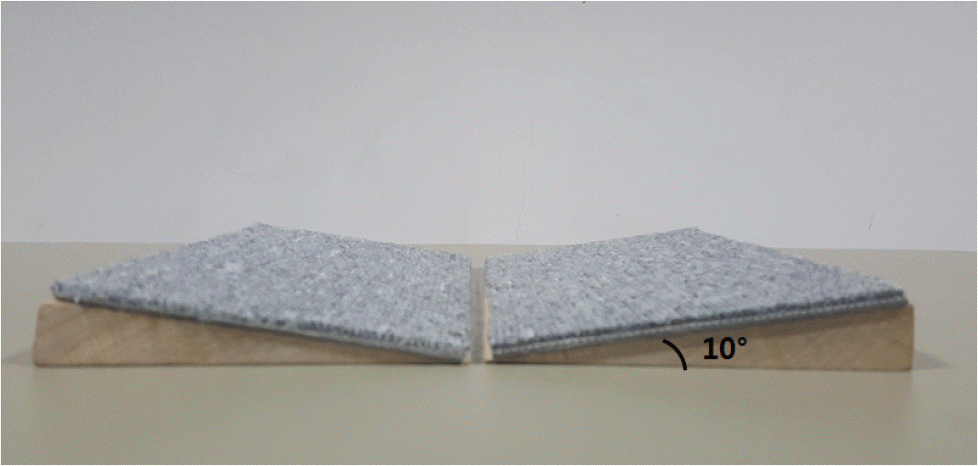초록
Background
Although postural instability is one of the major symptoms of Parkinson's disease (PD), dopaminergic treatment is ineffective for treating postural instability. Recent reports have shown that somatosensory deficit is associated with postural instability, and that somatosensory input improved postural instability. The purpose of this study is to evaluate the effects of lateral wedges for quiet standing postural control in people with PD.
Methods
Twenty-two patients who were diagnosed with PD were enrolled in this study. The participants stood on a force plate under two conditions (wedge and no wedge) with or without having their eyes open or closed. The center of pressure (COP) range and velocity were analyzed using a two-way repeated-measures analysis of variance.
Results
The range and velocity of COP in the anterioposterior and mediolateral (ML) directions were significantly improved after the patients stood on the lateral wedge with their eyes closed (p < 0.05). The range in ML direction and velocity in both directions of COP were significantly decreased when their eyes were open (p < 0.05).
Go to : 
REFERENCES
1.Mancini M., Carlson-Kuhta P., Zampieri C., Nutt JG., Chiari L., Horak FB. Postural sway as a marker of progression in Parkinson's disease: a pilot longitudinal study. Gait Posture. 2012. 36:471–476.

2.Bonnet CT., Delval A., Defebvre L. Interest of active posturogra-phy to detect age-related and early Parkinson's disease-related impairments in mediolateral postural control. J Neurophysiol. 2014. 112:2638–2646.

3.Mittelstaedt H. A new solution to the problem of the subjective vertical. Naturwissenschaften. 1983. 70:272–281.

4.Simoneau GG., Degner RM., Kramper CA., Kittleson KH. Changes in ankle joint proprioception resulting from strips of athletic tape applied over the skin. J Athl Train. 1997. 32:141–147.
5.Hatton AL., Dixon J., Rome K., Martin D. Standing on textured sur-faces: effects on standing balance in healthy older adults. Age Ageing. 2011. 40:363–368.

6.Morasso PG., Sanguineti V. Ankle muscle stiffness alone can-not stabilize balance during quiet standing. J Neurophysiol. 2002. 88:2157–2162.

7.Ganesan M., Lee YJ., Aruin AS. The effect of lateral or medial wedges on control of postural sway in standing. Gait Posture. 2014. 39:899–903.

8.Hughes AJ., Daniel SE., Blankson S., Lees AJ. A clinicopatho-logic study of 100 cases of Parkinson's disease. Arch Neurol. 1993. 50:140–148.

9.Stylianou AP., McVey MA., Lyons KE., Pahwa R., Luchies CW. Postural sway in patients with mild to moderate Parkinson's disease. Int J Neurosci. 2011. 121:614–621.

10.Qiu F., Cole MH., Davids KW., Hennig EM., Silburn PA., Netscher H, et al. Effects of textured insoles on balance in people with Parkinson's disease. PLoS One. 2013. 8:e83309.

11.Carpenter MG., Allum JH., Honegger F., Adkin AL., Bloem BR. Postural abnormalities to multidirectional stance perturbations in Parkinson's disease. J Neurol Neurosurg Psychiatry. 2004. 75:1245–12.

12.Lang CB., Kearney RE. Modulation of ankle stiffness during postural sway. Conf Proc IEEE Eng Med Biol Soc. 2014. 2014:4062–4065.

13.Nolano M., Provitera V., Estraneo A., Selim MM., Caporaso G., Stancanelli A, et al. Sensory deficit in Parkinson's disease: evidence of a cutaneous denervation. Brain. 2008. 131(Pt 7):1903–1911.

14.van Wegen E., de Goede C., Lim I., Rietberg M., Nieuwboer A., Willems A, et al. The effect of rhythmic somatosensory cue-ing on gait in patients with Parkinson's disease. J Neurol Sci. 2006. 248:210–214.

15.Ushio M., Murofushi T., Okita W., Suzuki M., Kaga K. The effective-ness of wedge shoes in patients with insufficient vestibular com-pensation. Auris Nasus Larynx. 2007. 34:155–158.

16.Blaszczyk JW., Orawiec R., Duda-Klodowska D., Opala G. Assess-ment of postural instability in patients with Parkinson's disease. Exp Brain Res. 2007. 183:107–114.

Go to : 
 | Fig. 1.Lateral wedges. Participants stood on flat surface and with lateral wedges at 10 degrees in forced platform, which can measure the center of pressure. |
Table 1.
Participant's demographic data
| PD (n = 22) | |
|---|---|
| Age (years) | 70.1 (10.4) |
| Gender | 12 males/10 females |
| Height (cm) | 160.4 (11.8) |
| Mass (kg) | 64.0 (12.1) |
| BMI (kg/m2) | 24.7 (2.4) |
| Modified H&Y scale | 1.8 (0.8) |
| UPDRS III | 17.3 (6.4) |
Table 2.
Comparison of the center of pressure based on variables in the experimental conditions
| Direction | Parameters | No wedge | Wedge | p-value | ||||
|---|---|---|---|---|---|---|---|---|
| Eyes open | Eyes closed | Eyes open | Eyes closed | Wedge | Vision | Interaction | ||
| AP direction | Range (cm) | 3.17 (1.46) | 3.51 (1.66) | 3.32 (1.91) | 3.27 (1.67) | 0.805 | 0.627 | 0.264 |
| Velocity (cm/s) | 37.07 (9.73) | 36.52 (9.46) | 34.52 (8.35) | 33.92 (7.89) | 0.002 a | 0.059 | 0.925 | |
| ML direction | Range (cm) | 2.47 (1.56) | 2.68 (1.78) | 2.05 (1.26) | 2.10 (1.89) | 0.002 a | 0.529 | 0.559 |
| Velocity (cm/s) | 42.71 (9.03) | 43.53 (10.11) | 41.67 (8.47) | 41.89 (8.13) | 0.008 a | 0.026 a | 0.232 | |
Values are presented as mean (SD). Wedge-p-value < 0.05 means that there is a statistically significant difference between with and without wedge re-gardless of the vision. Vision-p-value < 0.05 means that there is a statistically significant difference between eye open and closed. Interaction-p-value < 0.05 means that there is a statistically significant difference between with and without wedge, eye open and closed. AP, anterio-posterior; ML, mediolateral.




 PDF
PDF ePub
ePub Citation
Citation Print
Print


 XML Download
XML Download